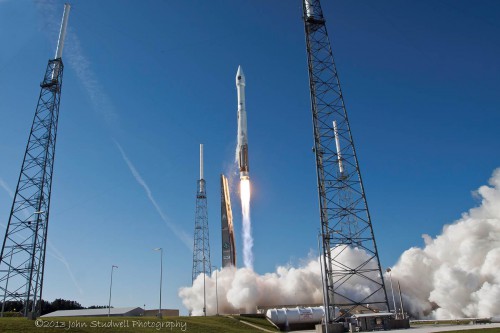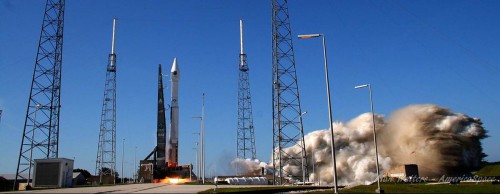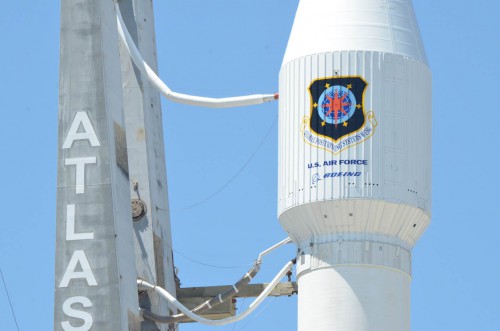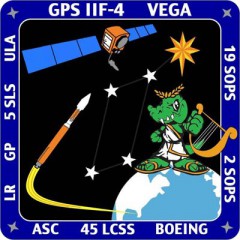
CAPE CANAVERAL, Fla — United Launch Alliance (ULA) has successfully launched its Atlas V rocket on an ambitious mission to insert the Global Positioning System (GPS) IIF-4 satellite into medium orbit, more than 11,000 miles above Earth. Liftoff of the reliable Atlas—which flew in its “401” configuration, with a 4-meter-wide (13-foot) payload fairing, no strap-on rocket boosters and a single-engine Centaur upper stage—occurred from Space Launch Complex (SLC)-41 at Cape Canaveral Air Force Station, Fla., at 5:38 p.m. EDT, precisely on the opening of the 18-minute “window.” According to AmericaSpace’s Launch Tracker, the Atlas rose into perfect blue skies.
The Atlas V was transferred the distance of a little over a quarter of a mile from the Vehicle Integration Facility (VIF) early yesterday morning. The journey took approximately 50 minutes and concluded with the vehicle being “hard down” on the SLC-41 pad surface. In the hours preceding today’s launch, U.S. Air Force meteorologists predicted a 90-percent likelihood of acceptable conditions at T-zero, their primary concern of note centering on the presence of cumulus clouds.

A smooth processing flow at SLC-41 preceded this mission, which marked the 38th flight of the Atlas V since its maiden voyage in August 2002. The vehicle has proven exceptionally reliable, delivering a variety of scientific and military payloads into orbit. Its sole career blemish occurred in June 2007, when a Centaur glitch produced a lower than intended orbit for its classified National Reconnaissance Office cargo. Standing 19 stories tall and capped-off by a bulbous, two-piece (“bisector”) payload fairing, the Atlas V 401 configuration has already flown three times this year, delivering NASA’s latest Tracking and Data Relay Satellite (TDRS-K), the Landsat Data Continuity Mission (LDCM), and the Pentagon’s Space-Based Infrared System for Geosynchronous Orbit (SBIRS GEO-2) in January, February, and March.
The Atlas’ Russian-built RD-180 engine, with a propulsive yield of 860,000 pounds, was designed to burn liquid oxygen and a refined form of rocket-grade kerosene, known as “RP-1,” for a little over four minutes. An hour ahead of launch, the lengthy fueling protocol was completed and the rocket entered a process of “topping off” of the liquid oxygen to compensate for the effects of cryogenic boil-off and ensure that the tanks were at full capacity at the instant of liftoff. Two pre-planned “holds” were built into the countdown flow, the last of which began at the T-4 minute mark at 5:14 p.m. EDT and lasted for 20 minutes. “This gives the launch controller and flight engineers a chance to do final system checks,” noted AmericaSpace’s Launch Tracker, “and make any last-minute adjustments to the flight plan before entering the Terminal Countdown.”

With no technical issues being worked, and weather conditions within required limits, a final poll of all stations by United Launch Alliance controllers produced a unanimous “Go” for launch and the countdown clock resumed at 5:34 p.m. Within the final four minutes, the Terminal Countdown picked up, the Flight Termination System—used to destroy the vehicle in the event of a major off-nominal situation—was armed, and the Atlas V systems transitioned to internal power.
Precisely on time, at 5:38:00 p.m., the RD-180 engine ignited about 2.7 seconds ahead of liftoff and began ramping up to full power, with the release of the pad hold-down clamps and liftoff at T+1.1 seconds. The Atlas climbed vertically for 18 seconds, after which the avionics of the Centaur commanded a pitch, roll, and yaw program maneuver to establish itself on a north-easterly trajectory and a flight azimuth of 45.8 degrees. The rapidly-ascending rocket broke through the sound barrier about 80 seconds into the flight and “Max Q”—the period of maximum aerodynamic turbulence upon the vehicle—occurred shortly thereafter.

The launch marked the first Atlas launch in almost 28 years to ferry a GPS satellite into orbit. The last occasion was on 9 October 1985, when an Atlas E/F rocket transported the GPS I-11 payload aloft from Vandenberg Air Force Base, Calif. It is intended that the 12-satellite GPS IIF network will employ a mix of both Atlas V and Delta IV launches.
Throughout the ascent phase, telemetry data was gathered by the Eastern Range, together with various worldwide installations under the U.S. Air Force Space Control Network: New Boston Air Force Station, N.H., the Royal Air Force’s Oakhanger installation in Hampshire, England, Diego Garcia in the Indian Ocean, and Guam in the western Pacific Ocean. Additionally, NASA’s Tracking and Data Relay Satellite constellation participated in the gathering of telemetry during the mission.
The Atlas’ RD-180 engine burned for a little over four minutes, shutting down and separating the Centaur and the attached GPS IIF-4 payload. The combo drifted for several seconds, ahead of the first of two “burns” of the Centaur’s restartable RL-10A engine at 5:42 p.m. This engine produced a maximum thrust of 22,300 pounds. This engine employs cryogenic liquid oxygen and hydrogen propellants, and its first firing lasted 13 minutes, after which the 41-foot-long Centaur/payload coasted for around three hours, ahead of a second burn, lasting just 1.5 minutes. Following the completion of the second burn, the Centaur spun-up GPS IIF-4 to five revolutions per minute, and the 3,600-pound satellite was scheduled to be deployed at T+3 hours and 23 minutes. At the time of writing, the Centaur performance was described as nominal.

Inserted into a semi-synchronous orbit of 11,047 miles, inclined 55 degrees to the equator, GPS IIF-4 will circle the globe once every 12 hours. It is expected to complete testing in August, after which it will be utilized as a “reserve” or “backup” satellite. This latest global-positioning asset will mark the fourth satellite in a 12-strong network of GPS IIF spacecraft, the first of which was boosted into orbit in May 2010. A second spacecraft flew in July 2011, followed by last October’s launch of GPS IIF-3 atop a Delta IV Medium rocket.
The GPS IIF-4 payload arrived at Cape Canaveral Air Force Station from prime contractor Boeing’s Satellite Development Center in El Segundo, Calif., aboard a C-17 Globemaster III aircraft on 26 February 2013. The GPS IIF boasts improved positioning, velocity, and timing accuracy, a reprogrammable processor, an interference-free civilian signal for commercial aviation search and rescue, and a new Military code (or “M-code”) to offer better resistance to electronic jamming.
“As each IIF satellite becomes operational, we continue the seamless transformation of the GPS constellation into an even more accurate, reliable, and durable navigation resource for the U.S. military and the global civilian user community,” said Craig Cooning, vice-president and general manager of Boeing Space & Intelligence Systems. “Our efficient pulse-line manufacturing process, adapted from Boeing’s commercial airplane production lines, also ensures that we deliver each spacecraft on time and on cost.”
In the meantime, the U.S. Air Force expects the next-generation GPS IIIA network to enter service from 2014. It awarded a $1.4 billion contract to Lockheed Martin in May 2008 to develop this new network, which may eventually comprise as many as 32 satellites, although the Air Force has only formally contracted for four of these. With 500 times the transmitter power of current systems, the IIIA satellites will benefit from improved navigational warfare capabilities, enabling them to shut off GPS services to limited geographical locations, whilst maintaining service to U.S. and allied forces. The GPS satellite system is operated and controlled by the 50th Space Wing, located at Schriever Air Force Base, Colo.
Want to keep up-to-date with all things space? Be sure to “Like” AmericaSpace on Facebook and follow us on Twitter:@AmericaSpace




CANNOT BELIEVE HOW FAST YOU GOT THIS ALL TOGETHER & UP!!! ABSOLUTELY THE MOST WONDERFULLY DETAILED & COMPLETE WRITE-UP OF A LAUNCH I’VE SEEN TO DATE…..METICULOUS IN DETAIL, UNDERSTANDABLE, INTERESTING & GREAT PICS !!! SPEED, QUALITY & DETAIL RARELY COME TOGETHER…BUT IT SURE DID HERE!!!! CONGRATULATIONS TO ALL……. SCIENTISTS, TECHNICIANS, WRITERS, PHOTOGRAPHERS, ADVERTISERS…..KEEP IT COMING!!! COULD NOT BE DONE BETTER THAN THIS…THAN YOU ALL!!!!